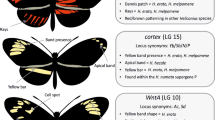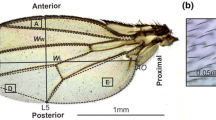Abstract
Artificial selection was carried out for over 45 generations to enhance and suppress expression of the mutation hairy on the Drosophila melanogaster wing. Whole chromosome mapping of X‐linked and autosomal modifiers of sense organ number displayed regional differences in magnitude and direction of their effects. Regional specificity of modifier effects was also seen in some interchromosomal interactions. Scanning electron microscopy allowed precise measurement of sense organ size and position along the L3 longitudinal wing vein. Sense organ size varied in a predictable fashion along the proximal–distal axis, and the dorsal pattern differed from the ventral pattern. The high and low selection lines differed most in the proximal portion of the L3 vein. Extra sense organs in the High line were often associated with vein fragments at locations predicted from ancestral vein patterns. Thus, regional specificity of polygenic or quantitative trait locus modifier effects was identified in several different parts of the wing.
Similar content being viewed by others
References
Blair, S.S., A. Giangrande, J.B. Skeath & J. Palka, 1992. The development of normal and ectopic sensilla in the wings of hairy and Hairy wing mutants of Drosophila. Mech. Dev. 38: 3–16.
Botas, J., J. Moscoso del Prado & A. García-Bellido, 1982. Genedose titration analysis in the search of trans-regulatory genes in Drosophila. EMBO J. 1 (3): 307–310.
Campos-Ortega, J.A. & Y.N. Jan, 1991. Genetic and molecular bases of neurogenesis in Drosophila melanogaster. Annu. Rev. Neurosci. 14: 399–420.
Dambly-Chaudière, C. & M. Vervoort, 1998. The bHLH genes in neural development. Int. J. Dev. Biol. 42: 269–273.
García-Bellido, A., 1977. Inductive mechanisms in the process of wing vein formation in Drosophila. Wilhelm Roux's Archives 182: 93–106.
Ghysen, A. & C. Dambly-Chaudière, 1988. From DNA to form: the achaete-scute complex. Genes Dev. 2: 495–501.
Ghysen, A., C. Dambly-Chaudière, L.Y. Jan & Y.N. Jan, 1993. Cell interactions and gene interactions in peripheral neurogenesis. Genes Dev. 7: 723–733.
Hassan, B. & H. Vaessin, 1996. Regulatory interactions during early neurogenesis in Drosophila. Dev. Genetics 18: 18–27.
Held, L.I., Jr., 1991. Bristle patterning in Drosophila. BioEssays 13(12): 633–640.
Ingham, P.W., S.M. Pinchin, K.R. Howard & D. Ish-Horowicz, 1985. Genetic analysis of the hairy locus in Drosophila melanogaster. Genetics 111: 463–486.
Jan, Y.N. & L.Y. Jan, 1993. The peripheral nervous system, pp. 1207–1240 in The Development of Drosophila melanogaster, edited by M. Bate & A. Martinez Arias. Cold Spring Harbor Laboratory Press.
Jiménez, F. & J. Modolell, 1993. Neural fate specification in Drosophila. Current Opinion in Gene. Dev. 3: 626–632.
Lindsley, D.L. & G.G. Zimm, 1992. The Genome of Drosophila melanogaster. New York: Academic Press, Inc.
Lynch, M. & B. Walsh, 1998. Genetics and Analysis of Quantitative Traits. Sinauer Associates, Inc., Sunderland, MA.
Mather, K., 1943. Polygenic inheritance and natural selection. Biol. Rev. 18: 32–64.
Moscoso del Prado, J. & A. Garcia-Bellido, 1984. Genetic regulation of the achaete-scute complex in Drosophila melanogaster. Roux's Arch. Dev. Biol. 193: 242–245.
Oshako, S., J. Hyer, G. Panganiban, I. Oliver & M. Caudy, 1994. Hairy function as a DNA-binding helix-loop-helix repressor of Drosophila sense organ formation. Genes Dev. 8: 2743–2755.
Rushlow, C.A., A. Hogan, S.M. Pinchin, K.M., Howe, M. Lardelli & D. Ish-Horowicz, 1989. The Drosophila hairy protein acts in both segmentation and bristle patterning and shows homology to N-myc. The EMBO J. 8(10): 3095–3103.
Schnee, F.B. & J.N. Thompson, Jr., 1984. Conditional polygenic effects in the sternopleural bristle system of Drosophila melanogaster. Genetics 60: 71–76.
Sturtevant, A.H., 1970. Studies on the bristle pattern of Drosophila. Dev. Biol. 21: 48–61.
Thoday, J.M. & J.N. Thompson, Jr., 1976. The number of segregating genes implied by continuous variation. Genetica 46: 335–344.
Thompson, J.N., Jr., 1974. Studies on the nature and function of polygenic loci in Drosophila. II. The subthreshold wing vein pattern revealed in selection experiments. Heredity 33: 389–401.
Thompson, J.N., Jr., 1975a. Quantitative variation and gene number. Nature 258: 665–668.
Thompson, J.N., Jr., 1975b. Studies on the nature and function of polygenic loci in Drosophila. III. veinlet modifiers having region-specific effects upon the vein pattern. Genetics 81: 387–402.
Thompson, J.N., Jr., 1977. Analysis of gene number and polygenic systems. Stadler Symp. 9: 63–82.
Thompson, J.N., Jr. & A.D. Preston, 1992. The Drosophila segmentation gene hairy responds to a late postembryonic gradient in the wing. Dros. Inf. Serv. 71: 247–249.
Thompson, J.N., Jr. & R.C. Woodruff, 1982. Polygenic analysis of pattern formation: Interdependence among veins in the same compartment of the Drosophila wing. Genetica 60: 71–76.
Thompson, J.N., Jr., J.J. Hellack & J.S. Kennedy, 1982. Polygenic analysis of pattern formation in Drosophila: Specification of companiform sensilla positions on the wing. Dev. Genetics 3: 115–128.
Vaessin, H., M. Caudy, E. Bier, L.Y. Jan & Y.N. Jan, 1990. Role of helix-loop-helix proteins in Drosophila neurogenesis. Cold Spring Harbor Symposium on Quantitative Biology, 55: 239–245.
Van Doren, M., A.M. Bailey, J. Esnayra, K. Ede & J.W. Posakony, 1994. Negative regulation of proneural gene activity: hairy is a direct transcriptional repressor of achaete. Genes Dev. 8: 2729–2742.
Weber, K., R. Eisman, L. Morey, A. Patty, J. Sparks, M. Tausek & Z.B. Zeng, 1999. An analysis of polygenes affecting wing shape on chromosome 3 in Drosophila melanogaster. Genetics 153: 773–786.
Zimmerman, E., A. Palsson & G. Gibson, 2000. Quantitative trait loci affecting components of wing shape in Drosophila melanogaster. Genetics 155: 671–683.
Author information
Authors and Affiliations
Rights and permissions
About this article
Cite this article
Fletcher, R.B., Thompson, J.N. Spatial differences in patterns of modification: selection on hairy in Drosophila melanogaster wings. Genetica 109, 169–181 (2000). https://doi.org/10.1023/A:1017531404454
Issue Date:
DOI: https://doi.org/10.1023/A:1017531404454




